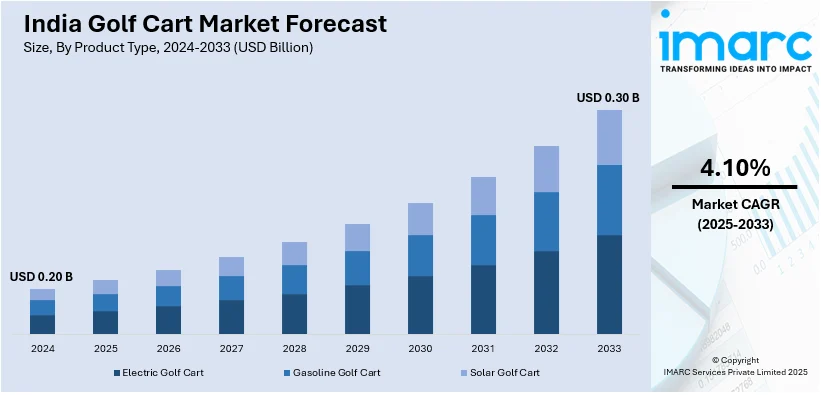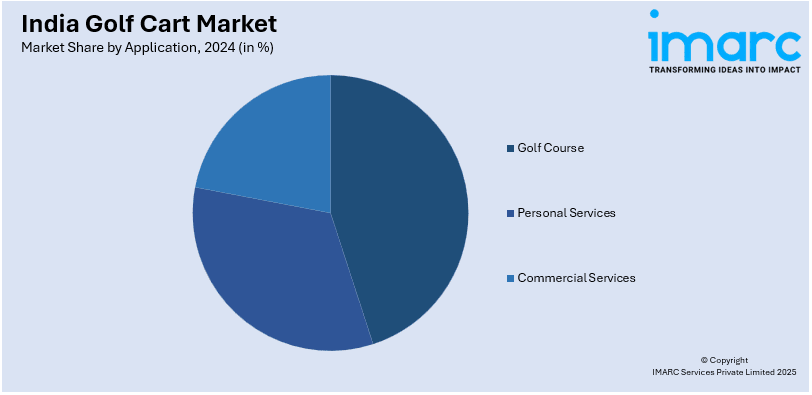
India Golf Cart Market Size, Share, Trends and Forecast by Product Type, Application, Seating Capacity, and Region, 2025-2033
India Golf Cart Market Overview:
The India golf cart market size reached USD 0.20 Billion in 2024. Looking forward, IMARC Group expects the market to reach USD 0.30 Billion by 2033, exhibiting a growth rate (CAGR) of 4.10% during 2025-2033. The market is driven by increasing demand for eco-friendly transportation, government initiatives promoting clean energy, and urbanization. Adoption in gated communities, resorts, and industrial complexes, along with advancements in electric vehicle technology and smart features, further augments the India golf cart market share. Rising environmental awareness and cost-effective solutions also contribute to market expansion.
|
Report Attribute
|
Key Statistics
|
|---|---|
|
Base Year
|
2024 |
|
Forecast Years
|
2025-2033
|
|
Historical Years
|
2019-2024
|
| Market Size in 2024 | USD 0.20 Billion |
| Market Forecast in 2033 | USD 0.30 Billion |
| Market Growth Rate 2025-2033 | 4.10% |
India Golf Cart Market Trends:
Rising Demand for Eco-Friendly Transportation Solutions
The growing emphasis on eco-friendly transportation solutions is creating a positive India golf cart market outlook. With increasing awareness about environmental sustainability and the need to reduce carbon emissions, golf carts are being adopted beyond traditional golf courses. They are now widely used in gated communities, resorts, airports, and industrial complexes as a green alternative to conventional vehicles. On 25th December 2024, Mussoorie started a golf cart service on its Mall Road as part of a major tourist and urban mobility drive. Launched in association with the Nagar Palika and local rickshaw drivers, this service enhances environment-friendly transport options. There are plans to expand both the routes and the number of carts, which reflects India's need for environmentally friendly golf carts for urban mobility. Along with this, the Indian government’s push for cleaner energy and stricter emission norms further accelerates this trend. Additionally, the availability of electric golf carts, which are cost-effective and low-maintenance, has made them an attractive option for short-distance travel. As urbanization continues to expand, the demand for compact, energy-efficient vehicles such as golf carts is expected to grow, positioning them as a key player in India’s sustainable mobility landscape.

To get more information on this market, Request Sample
Integration of Advanced Technology and Smart Features
The integration of advanced technology and smart features is significantly supporting the India gold cart market growth. Manufacturers are increasingly incorporating IoT-enabled systems, GPS navigation, and battery management systems to enhance the functionality and user experience of golf carts. These innovations are particularly appealing to commercial sectors such as hospitality and tourism, where efficiency and customer satisfaction are paramount. Furthermore, the rise of lithium-ion batteries improves the performance and range of electric golf carts, making them more reliable for longer distances. The trend toward automation and connectivity is also gaining traction, with features such as remote monitoring and predictive maintenance becoming standard in high-end models. As technology continues to change, the market is poised to witness a transformation, catering to the growing demand for smarter and more efficient mobility solutions. As per a study, 40% of Indian consumers prefer hybrid vehicles over electric vehicles (EVs), while 85% are interested in premium models. This represents an important shift in consumer tastes when it comes to human locomotion. Currently, utility vehicles (UVs) and sport utility vehicles (SUVs) comprise 65% of total sales, potentially heralding the transition to sustainable alternatives, such as electric golf carts used in both urban and commercial settings. With electric vehicle infrastructure getting established, hybrid and alternative mobility solutions are gradually gaining traction in India.
India Golf Cart Market Segmentation:
IMARC Group provides an analysis of the key trends in each segment of the market, along with forecasts at the country level for 2025-2033. Our report has categorized the market based on product type, application, and seating capacity.
Product Type Insights:
- Electric Golf Cart
- Gasoline Golf Cart
- Solar Golf Cart
The report has provided a detailed breakup and analysis of the market based on the product type. This includes electric golf cart, gasoline golf cart, and solar golf cart.
Application Insights:

- Golf Course
- Personal Services
- Commercial Services
A detailed breakup and analysis of the market based on the application have also been provided in the report. This includes golf course, personal services, and commercial services.
Seating Capacity Insights:
- Small (2-4 Seater)
- Medium (6-8 Seater)
- Large (Above 8 Seats)
The report has provided a detailed breakup and analysis of the market based on the seating capacity. This includes small (2-4 seater), medium (6-8 seater), and large (above 8 seats).
Regional Insights:
- North India
- South India
- East India
- West India
The report has also provided a comprehensive analysis of all the major regional markets, which include North India, South India, East India, and West India.
Competitive Landscape:
The market research report has also provided a comprehensive analysis of the competitive landscape. Competitive analysis such as market structure, key player positioning, top winning strategies, competitive dashboard, and company evaluation quadrant has been covered in the report. Also, detailed profiles of all major companies have been provided.
India Golf Cart Market News:
- On November 28, 2024, Lucknow district officials announced plans to enhance the 1.2-kilometer heritage stretch from Tilewali Masjid to Chota Imambara by introducing walking tours and regulated golf cart services. To alleviate congestion, heavy vehicles will be prohibited from operating or parking near key heritage sites.
India Golf Cart Market Report Coverage:
| Report Features | Details |
|---|---|
| Base Year of the Analysis | 2024 |
| Historical Period | 2019-2024 |
| Forecast Period | 2025-2033 |
| Units | Billion USD |
| Scope of the Report |
Exploration of Historical Trends and Market Outlook, Industry Catalysts and Challenges, Segment-Wise Historical and Future Market Assessment:
|
| Product Types Covered | Electric Golf Cart, Gasoline Golf Cart, Solar Golf Cart |
| Applications Covered | Golf Course, Personal Services, Commercial Services |
| Seating Capacities Covered | Small (2-4 Seater), Medium (6-8 Seater), Large (Above 8 Seats) |
| Regions Covered | North India, South India, East India, West India |
| Customization Scope | 10% Free Customization |
| Post-Sale Analyst Support | 10-12 Weeks |
| Delivery Format | PDF and Excel through Email (We can also provide the editable version of the report in PPT/Word format on special request) |
Key Questions Answered in This Report:
- How has the India golf cart market performed so far and how will it perform in the coming years?
- What is the breakup of the India golf cart market on the basis of product type?
- What is the breakup of the India golf cart market on the basis of application?
- What is the breakup of the India golf cart market on the basis of seating capacity?
- What is the breakup of the India golf cart market on the basis of region?
- What are the various stages in the value chain of the India golf cart market?
- What are the key driving factors and challenges in the India golf cart market?
- What is the structure of the India golf cart market and who are the key players?
- What is the degree of competition in the India golf cart market?
Key Benefits for Stakeholders:
- IMARC’s industry report offers a comprehensive quantitative analysis of various market segments, historical and current market trends, market forecasts, and dynamics of the India golf cart market from 2019-2033.
- The research report provides the latest information on the market drivers, challenges, and opportunities in the India golf cart market.
- Porter's five forces analysis assist stakeholders in assessing the impact of new entrants, competitive rivalry, supplier power, buyer power, and the threat of substitution. It helps stakeholders to analyze the level of competition within the India golf cart industry and its attractiveness.
- Competitive landscape allows stakeholders to understand their competitive environment and provides an insight into the current positions of key players in the market.
Need more help?
- Speak to our experienced analysts for insights on the current market scenarios.
- Include additional segments and countries to customize the report as per your requirement.
- Gain an unparalleled competitive advantage in your domain by understanding how to utilize the report and positively impacting your operations and revenue.
- For further assistance, please connect with our analysts.
 Request Customization
Request Customization
 Speak to an Analyst
Speak to an Analyst
 Request Brochure
Request Brochure
 Inquire Before Buying
Inquire Before Buying




.webp)




.webp)












